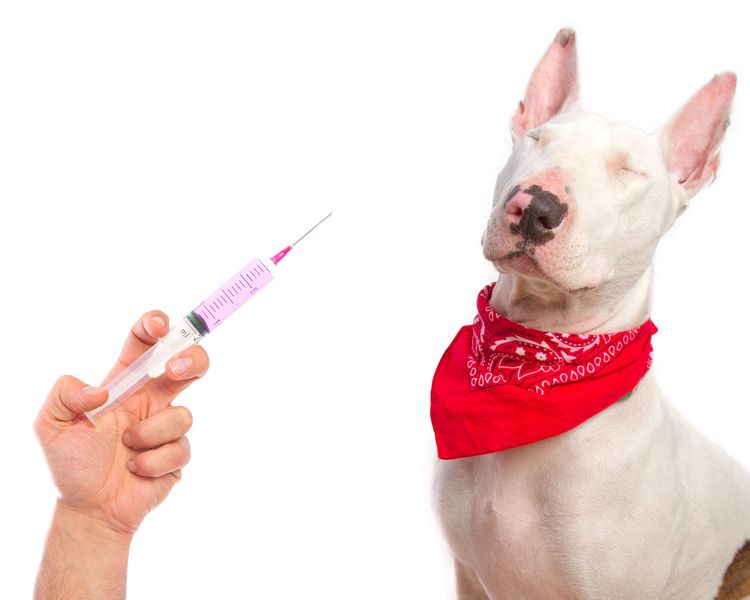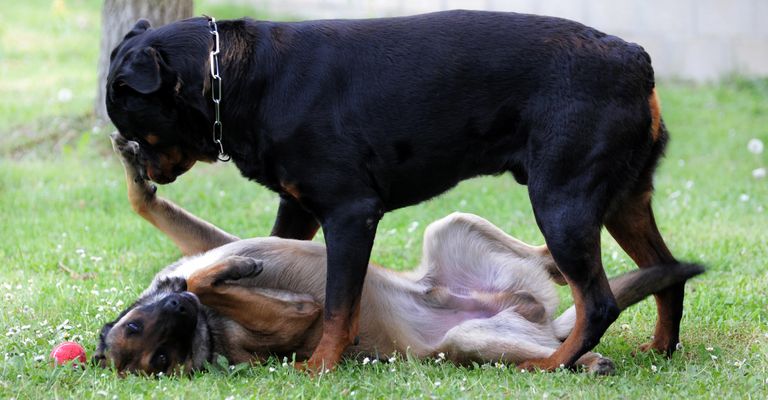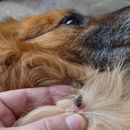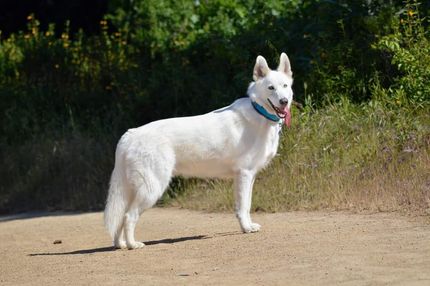What happens with a castration chip?
Normally, the male dog's hypothalamus produces gonadotropin-releasing hormones (GnRH), which stimulate the pituitary gland to release gonadotropins, which in turn stimulate the testicles to produce testosterone. The active ingredient in the castration chip, deslorelin, is a GnRH agonist.
At the start of treatment, it leads to an increased release of gonadotropins, which can temporarily increase sexual behavior. The chip then continuously releases small amounts of the GnRH agonist, which saturates the corresponding receptors and stops testicular activity. As long as the active substance is active, the male dog remains infertile.
Function of GnRH
GnRH is an important hormone in dogs and humans that controls reproduction. It is produced in the hypothalamus and is released in a pulsatile rhythm, i.e. in pulses, depending on the reproductive stage.
GnRH binds to the receptors of the pituitary g land (pituitary gland) and stimulates the release of the sex hormones LH and FSH. These are also released in a pulsatile rhythm, whereby the amount of LH/FSH depends on the amount of GnRH bound.
Role of LH and FSH
FSH is responsible for follicle formation, maturation and ovulation in females and for sperm production in males. LH promotes the formation and release of oestrogen and testosterone, which regulate the sexual cycle and reproduction.
Castration chip or surgical intervention?
In principle, the hormone chip works in a similar way to surgical castration, but there are two main differences:
Temporary effect of the hormone chip
The hormone chip offers a non-permanent solution, which means that negative effects such as weight gain, incontinence or anxiety and aggression problems are reversible. As soon as the chip has dissolved, the animal's behavior and body return to their original state. Surgical castration, on the other hand, is irreversible and the effects remain for life.
As many behaviors cannot be changed or worsened by castration, the hormone chip offers the opportunity to test the effects in advance. If the result is satisfactory, the chip can be reinserted or a final surgical castration can be performed. If the result does not meet expectations, you can wait for the chip to wear off and consider other therapeutic approaches such as behavioral therapy.
Initial phase and "flare-up" effect
In the first two weeks after insertion of the hormone chip, there may be a short-term increase in hormone-related behaviors, the so-called "flare-up". This is due to the GnRH effect, which causes an increase in LH and FSH, which can temporarily exacerbate sniffing, marking and aggression between males. This phase only lasts until the body has become accustomed to deslorelin.
Surgical castration does not have this effect as there are no reproductive organs left to respond to the increase in LH and FSH.

Active ingredient deslorelin in the Suprelorin®-Chip
The active ingredient deslorelin contained in the Suprelorin®-Chip is very similar to the body's own GnRH and can therefore bind to the same receptors and trigger similar reactions in the body. However, deslorelin is released continuously in small quantities from the chip, which has a stronger and more consistent effect than the pulsatile release of GnRH. This prevents hormone fluctuations and enables the desired effects: Interruption of the sexual cycle, suppression of reproductive function and prevention of sexual hormone-dependent behaviors.
Indications for use according to the package leaflet
- Male dog: Temporary infertility in healthy, unneutered, sexually mature male dogs.
- Prepubertal bitch: Temporary infertility to delay the first estrus, prevent signs of heat and avoid pregnancy in young, unspayed and healthy, sexually immature bitches. The implant should be inserted between 12 and 16 weeks of age.
- Male cats: Temporary infertility and suppression of urine odor and sexual behaviour such as sex drive, vocalizations, urine marking and aggressiveness in unneutered male cats from the age of 3 months.
Duration of effect of the castration chip
After the active ingredient deslorelin has completely dissolved and developed its effect, the effect of the chip is over. The duration of effect varies depending on the amount of active ingredient: the 4.7 mg chip is effective for at least six months, the 9.4 mg chip for at least twelve months. The duration of effect varies from person to person; in smaller dog breeds up to two years can be known.
How is it used?
With this method, the vet injects the castration chip under the dog's skin (subcutaneously) between the shoulder blades. It is important that the chip does not get into the fatty tissue, as this can impair its effectiveness.
Dissolution and onset of action
The chip gradually dissolves completely and does not need to be removed. It takes about 4 to 6 weeks for the chip to take full effect.

When should a castration chip not be used?
It is not advisable to use the castration chip (Suprelorin) in the case of penile bleeding , as it can trigger increased sexual activity in the initial phase, which means that the aim of avoiding erections is not achieved.
A castration chip should also not be used if the dog has existing health problems such as severe liver or kidney disease, or hormonal disorders or tumors of the reproductive organs. Young puppies that have not yet reached puberty should also not be given a castration chip, as their hormonal balance is not yet stable. Older dogs with a weak immune system or other age-related diseases may also have difficulty reacting to the hormonal changes.
Pregnant bitches should not be given a castration chip, as this could have a negative effect on the development of the fetuses.
Dogs that are allergic to deslorelin or similar substances are also not suitable candidates.
If you are unsure whether your dog is a suitable candidate, it is best to ask a vet!
Studies confirm safety
Many dog owners have concerns about the hormone chip. These fears are generally unfounded.
The hormone chip is not a technical device like a computer chip, but a small implant that slowly releases the active ingredient. The active ingredient contained in the chip corresponds to an endogenous hormone and has the same effect without any harmful side effects. The active ingredient is broken down in the body and excreted in the urine, so there are no long-term effects or permanent residues.
The effect of the hormone chip is also limited in time. Long-term damage is therefore not to be expected, which has been confirmed by various studies and practical experience.
The risks of the injection are also minimal. The chip is inserted subcutaneously, i.e. under the skin, which means that no muscles, bones or internal organs are injured. Only local irritation, a small bruise or itching may occur at the injection site, which usually heals quickly.
Conclusion
Hormone chips offer a non-surgical and reversible method of neutering dogs by suppressing reproductive function and controlling hormone-dependent behavior. They are particularly beneficial as they are less invasive than surgical castration. A veterinary consultation is crucial to make the best possible decision for the welfare of the dog.
Sources and relevant links
Berthe M, Haverkamp K, Wefstaedt P et al. (2020). Einfluss der chemischen Kastration auf das Prostata- und Hodenvolumen sowie den Testosteronspiegel beim Rüden. Tierärztliche Praxis Ausgabe K: Kleintiere / Heimtiere.
Strodtbeck S, Gansloßer U. (2010). Die Kastration des Rüden aus verhaltensbiologischer Sicht. Veterinärspiegel 04/2010.
Nadja Sigrist (2017). Notfallmedizin für Hund und Katze. Hrsg. 1. Auflage. Enke Verlag.
Thomas Steidl, Thomas Buyle, Hartwig Bostedt, Axel Wehrend (2020). Rechtssicherheit in der Tierarztpraxis. Hrsg. 1. Auflage. Thieme.




















